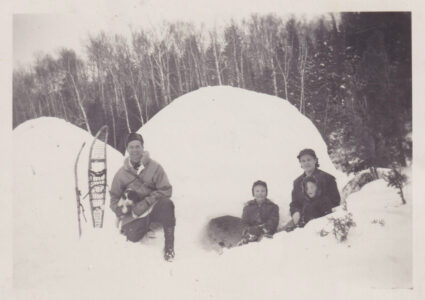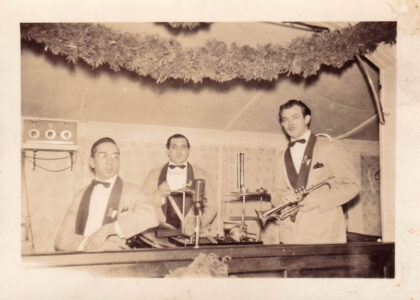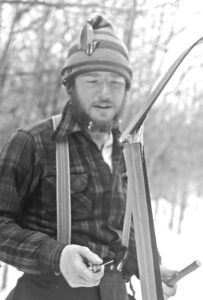Trackin’ down the tales
As a kid, I was as big a jabber-jaw as I am now. Talking was (and if you’re keeping count, still is) my favorite hobby. And why wouldn’t it be? It costs nothing and requires neither formal training, tools nor materials. And best of all — especially in light of today’s status quo — no electronics are involved.
If silence is golden, then to me face-to-face conversation is diamonds. — and it always has been. As a kid I talked to everyone, including — and against my mother’s strident warnings– strangers. I still do it, because how else can you meet new people?
While I was a DEI shmoozer, my favorite rap buddies were Old Guys. Of course, “old,” like “time,” is relative, and for the same reason. To me in single digits, 50 was AOG (Authentic Old Guy), 60 was AAOG (Ancient Authentic Old Guy) and 70 was too rare to be counted. Keep in mind, when I was 10, at the adolescence of the Atomic Age and the dawn of the Space Age, a 60-year-old could’ve served in WWI, was an adult long before antibiotics and preventative medicine and was 23 when the first commercial radio station took to the airwaves. In 1920, fewer than 5% of 23 year-olds had a college degree, and while in 2025 we have 298 million cars registered, in 1925 there were 17 million.
The AOGs and AAOGs had been through the Depression and WWII, had grown up with wood heat and were now delighted with oil. For most of them, their favorite vegetable was tobacco; their equivalent of of health clubs were bars and cocktail lounges, and they knew (as the wisdom of the day proclaimed) red meat was vital for survival.
Beyond that, their coin of the realm was socializing, and as a group they loved to talk. And that’s where Li’l Dopey Boy came in: I took in as many of their conversations as I could, usually as a listener, but sometimes as a participant (like most kids then, I knew where I fit in the adult world — seen, not heard). This was how I learned my chops as a decent shmoozer, a fair-to-middlin’ joke teller and a near-genius eavesdropper.
My tastes in subjects was catholic — I liked to hear anything they talked about — but my favorites were their Good Ole Days. Even then, though I didn’t realize it, I was a budding historian. And as one, I learned to classify my “sources” according to their reliability.
First were guys who were perfectly reliable. If they said something had happened, it had. Either they’d seen it, known another reliable person who had or had read it in a reputable source, which they could name. They might get some minor details wrong, but there was a lot of that going on then … as there is now.
The second bunch were the pathological liars. Essentially, everything they said was pure bunkum. They might, by the sheer volume of their bumpf, say something true. But then again, to use the old saw, even a blind chicken can find some corn. As a source, they were useless, but since everyone knew they were fulla crap, they provided that vital component of small town life called local color.
The third bunch were guys who didn’t intentionally lie, but who also didn’t vet their stuff. So their stories might’ve been true, or might’ve been embellished or might’ve even been the stuff of legends. But I listened to them all and tried to verify them as best I could. It was iffy work. Some tales I verified immediately; others I never verified and still others took decades to support. A fine example of the last one was the horse jumping off The Bluff (a 73-foot rock face on Bluff Island, on Lower Saranac Lake).
–
The Bluff was no bluff
–
As a wee poppet I’d heard that early in the century a movie had been filmed here, in which a man jumped a horse off The Bluff, and tragically the horse got killed. In my teen years I heard the rider had been Harry Duso, the owner of Crescent Bay marina. Since I didn’t know how much, if any of it, was true, I told the story, but always with the caveat that it could’ve been 100% rural legend.
Finally, in my mid-50’s I went directly to the horse’s mouth, as it were, and asked Don Duso, Harry’s son, how much of it was true. Don was totally reliable with local history, so I knew if he didn’t know the truth, he’d tell me so.
As for the real nitty-gritty? They did film a short movie here at The Bluff, back in 1914 (an episode of the famous serialized melodrama, “The Perils of Pauline”). In it, a man jumped a horse off The Bluff, but it was not Harry Duso. However, Harry had a walk-on part (or more exactly, a JUMP-ON part): Dressed as Pauline and chased by the villain, he jumped off the cliff. Most important: The horse, a stalwart trouper, survived in fine fettle.
Don also verified another local tale I’d heard for years, namely that he had saved Albert Einstein from drowning.
Einstein was a summer resident here for five or six years in the ’40s and ’50s, and he loved to sail. Sadly, for all his brilliance as a physicist, as a sailor he was a dud. There were many accounts of him floating around on Lower Saranac, hopelessly becalmed in our version of The Horse Latitudes, till some passing boater spotted him and towed him back to Knollwood.
I always figured he was a lousy sailor only because he didn’t care. Instead, I imagined him on the lake, in the fresh air and sunshine, and with the pleasure of his own company. To him, sailing in some specific direction was a distant concern (pardon the pun).
Something else about him and his fitness as a sea dog: He couldn’t swim, and he didn’t wear a life preserver. That combination made for a near-tragedy … and more importantly, a great local tale.
–
E= mc2 meets H2O
–
One fine day in 1941 he was taking advantage of the strong winds on the lake … till they took advantage of him and he capsized. When the boat heeled over, he got tossed out of the cockpit and somehow got tangled in the ropes. The more he struggled, the more trapped he became. The only good thing was the boat was on its side, so he was lying on the sail, and not struggling in the non-briney deep.
As he was thrashing around, deliverance came in a motorboat with 10-year-old Don Duso at the helm.
In terms of years alone, Don was a little kid. In terms of boats, he was a seasoned pro: He’d been hatched and raised at the marina and even at that age was at home in any boating situation. He came alongside (as we Navy types say), got Einstein free of his soggy bonds and motored him home, wetter but hopefully wiser.
Sadly, I don’t know any details about what, exactly, Don did to rescue Einstein, but that’s because Don was Don: He was a man of few words and not given to any self-promotion. So the way he told the story you woulda thunked snatching one of the world’s greatest thinkers out of the jaws of death was an everyday event.
Now a final note of Einsteinian Saranac Lake Lore: On Aug. 6, 1945, when the Enola Gay dropped the A-bomb on Hiroshima, Albert Einstein was sailing on Lower Saranac.
In those days, Einstein was popularly known as “The Smartest Man in the World.” And since he’d had his brush with a watery grave four years earlier, I’d like to think he’d learned his lesson and never sailed again without wearing a life preserver.
Then again, knowing what I’ve learned about men, I doubt it.



